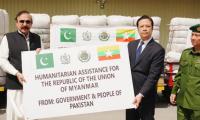ISLAMABAD: Pakistan was placed at 150 among 189 countries in UN’s 2018 Human Development Index (HDI)’s annual rankings that is measured by combining indicators of life expectancy, educational attainment and income.
The HDI forms part of the Human Development Report (HDR) 2018, a flagship study produced annually by the United Nations Development Programme (UNDP), which was released Friday.
The report is 28th in a series which began in 1990. The first UNDP Human Development Report (HDR) was prepared and launched under the leadership of the late Dr Mahbubul Haq, a former Pakistan finance minister.
In other South Asian countries, India ranked at 130 on the index; Bangladesh: 136; Sri Lanka: 76; Maldives: 101; Nepal: 149, and Bhutan 130. During the period, Pakistan’s HDI value was 0.562; life expectancy 66.6 years; average years of schooling 5.2 years and gross national income per capita $5,311. Oil-rich Norway, Switzerland, Australia, Ireland and Germany led the ranking, while Niger, the Central African Republic, South Sudan, Chad and Burundi have the lowest scores in the HDI’s measurement of national achievements in health, education and income.
Looking at the widening gap in real terms -- both among and within countries -- the report said that a child born in Norway today, the country with the highest human development index (HDI), can expect to live beyond the age of 82, and spend almost 18 years in school.
But the same child, if born in Niger, the lowest HDI, can expect only to live to 60, with just five years of formal education. "While these statistics present a stark picture in themselves, they also speak to the tragedy of millions of individuals whose lives are affected by inequity and lost opportunities, neither of which are inevitable,” Achim Steiner, the Administrator of the UN Development Programme (UNDP), which released the report.
Inequality occurs in many countries, including in some of the wealthiest ones, but it ends up taking a much bigger toll on countries with lower HDI levels; with low HDI countries losing almost a third of their human development capacity.
For countries with a high HDI, the average loss is 11 per cent. The striking differences both within and among countries, are stifling progress and the trend can be seen again and again, according to UNDP.
Inequality in all its forms and dimensions, between and within countries, limits people’s choices and opportunities, withholding progress, Selim Jahan, Director of the Human Development Report Office at UNDP, explained.
A key sources of inequality within countries is the gap in opportunities, achievements and empowerment between women and men. On average, the HDI for women is 6 per cent lower than that for men, notes the report. And when women are working, their unemployment rates are 24 per cent higher than their male counterparts. Women globally also do much more unpaid domestic and care work than men.
Furthermore, while there has been laudable progress’ in the number of girls attending school, there remain big differences in other key aspects of men and women’s lives, for instance labour force participation rates for women globally are lower than for men, 49 per cent, versus 75 per cent. "Women’s empowerment remains a particular challenge," underscored UNDP.
The Human Development Report 2018 update also shows tremendous variation between countries in quality of education, healthcare and many other key aspects of life.







